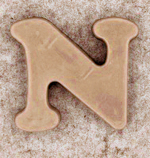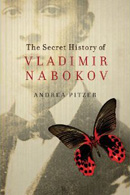Speak, playthings: Nabokov’s synesthesia and memory
For some people, sound has taste. Vladimir Nabokov saw the alphabet in color. Both are examples of synesthesia, in which a person experiences a second, paired sensation accompanying an initial different kind of sensory input.
A study out last month in Psychological Science suggests that though it is possible synesthesia is hardwired into individuals, many synesthetes’ particular color schemes seem to have their genesis in childhood toys. The study involved 11 people like Nabokov, said to have “color-grapheme” synesthesia—seeing color when looking at letters or numbers. Researchers managed to trace study subjects’ color associations to magnetic alphabet sets they used as children.
 Born in 1899, Nabokov seems unlikely to have possessed the colored refrigerator magnet alphabets that became ubiquitous more than half a century later. So what were Nabokov’s childhood toys?
Born in 1899, Nabokov seems unlikely to have possessed the colored refrigerator magnet alphabets that became ubiquitous more than half a century later. So what were Nabokov’s childhood toys?
In his autobiography, Speak, Memory, Nabokov lists the colors he saw for each letter. Among the greens are “alder-leaf f, the unripe apple of p, and pistachio t.” In the same section, he specifically mentions a set of old blocks he was building with one day as a child. Their colors, he told his mother, were “all wrong.” She turned out not only to have synesthesia, but also to share some color-letter combinations with him. This new study makes me wonder whether he had been exposed to a set of colored blocks—perhaps the same set, or a similar set—that his mother had encountered as a child, one that had formed his sense of what color went with a given letter.
Nabokov’s son Dmitri also had synesthesia and described his family’s experience with it in an afterword to Wednesday Is Indigo Blue, a book which suggests that one in twenty people has some form of the condition. Writing of the effect synesthesia had on Nabokov, Dmitri specifically notes its literary impact:
Perhaps the most significant domain in which synesthesia may have affected Vladimir Nabokov was that of metaphor. When he describes an object, be it a chance item or an important prop, odds are that his description will have not only a touch of originality but also a color.
Like the subjects in the January study, Dmitri mentions that the Nabokovs retained their specific color-letter pairings across many years.
I don’t dwell on Nabokov’s synesthesia in The Secret History, but I find the idea that it might have been triggered by or taken root in early childhood associations fascinating. In this new understanding of synesthesia, for at least some people who experience it, the past and the building blocks of words come together in memory to form a literal palette of language. Memory may have concretely shaped Nabokov’s literary vision long before he ever wrote a word.
Image credit: adapted via Creative Commons license from a Leo Reynolds’ photo on Flickr
